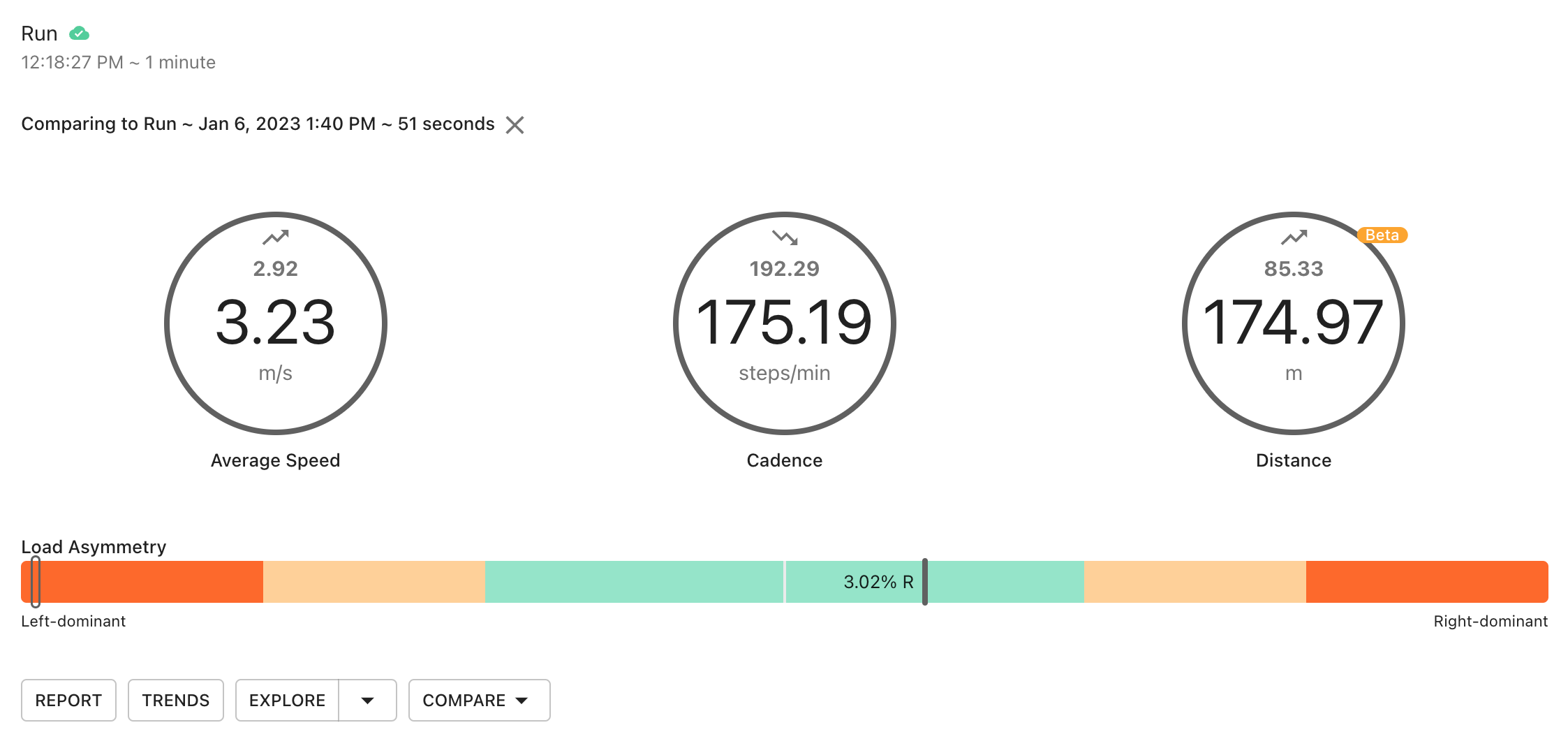Run Test
Measure running speed, ground contact time, and spatiotemporal gait parameters to characterize running capacity and performance.
What is a run test?
Acceleration profiles can indicate explosive power and musculoskeletal ability, and average speed and GCT can give insight into fatigue. The run test can be used in post-injury rehabilitation, performance, and general health. A practitioner can perform the run test to evaluate the areas of functional movement performance outlined below. Click on each section to learn more:
Movement quality and functional capacity
Movement control and adaptability
Propulsive and absorptive strategies with foot-ground interactions
Degree of inter-limb asymmetry for all of the above components of movement performance
-
Important: To track changes accurately over time, it's important to keep external conditions as consistent as possible. Try to use the same running route and length of time (at least 2 mins is recommended) for each activity.
1. Tester navigates to the measure page of the Plantiga app and selects the Run Test.
2. Tester selects the subject that will be performing the activity. Address any warnings that may come up once they have been selected.
3. Tester instructs the subject to stand still with feet planted firmly on the ground.
4. Tester starts the Run Test in their plantiga.io web application and the subject remains still as the stopwatch counts down from 5.
5. Subject begins running for the chosen time (this can be as short as a 40m sprint or a longer run for up to 2 hours).
6. Once the time elapses, the tester instructs the subject to stop and plant their feet firmly on the ground.
7. The tester stops the stopwatch once still, and the subject remains still for 5 seconds.
8. Tester fills out optional information (RPE, Pain, Floor type...) and saves the Run Test.
What does Plantiga measure?
Run speed: the average time it takes per defined distance, usually per kilometre (or mile). This is a reliable measure of one's endurance capacity.
Individuals with a higher lactate threshold and/or running economy can sustain higher run paces for longer throughout an activity.
Duty factor (DF): The percentage of the stride cycle that your foot is in contact with the ground. This reflects your running strategy on the aerial and terrestrial running styles continuum.
Aerial runners (low DF): Runners with a low DF reduce the energetic running cost by using their tissues' natural spring-like ability. They have longer flight times and shorter GCT.
Terrestrial runners (high DF): Runners with a high DF reduce the energetic cost of running by reducing vertical movement in favour of forward movement. They have longer GCT and shorter flight times.
Note that DF will decrease with increasing speed.
Ground contact time (GCT) asymmetry: a comparison of the time the left vs. right foot spends on the ground during a step cycle.
A GCT asymmetry presents as a limp.
When combined with high load asymmetry, GCT asymmetry results when the opposite limb is experiencing fatigue, weakness, or pain.
Vertical take-off acceleration (VTA) asymmetry: A comparison of how quickly the left vs. right foot swings immediately after toe-off.
When combined with a high GCT asymmetry on the same side, high VTA asymmetry (> 10%) occurs when the opposite limb is fatigued, weak, or experiencing pain.
When combined with a high GCT asymmetry on the opposite side, high VTA asymmetry indicates weaker ankle musculature.
Vertical landing acceleration (VLA) asymmetry: Vertical landing acceleration (VLA): A comparison of the ability of the left vs. right to absorb impact when the foot lands on the ground.
High VLA asymmetry (> 10%) occurs when landing more abruptly on one limb than the other.
High VLA and GCT asymmetry on the same side indicate compensatory shifting of loading demands away from the affected or weaker limb.
How can my athletes benefit from run testing with Plantiga?
To simplify data interpretation and provide actionable movement insights to our users for better rehabilitation and performance outcomes, we’ve created instant and customizable activity reporting tools that can be accessed and shared within minutes.

